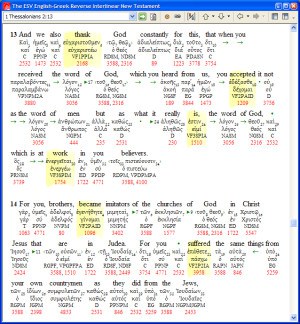Earlier I blogged about Highlighting English based on Greek Morphology. This involved using Logos Bible Software 3 and a Reverse Interlinear of the New Testament to highlight words based on the underlying language’s morphology (word form, part-of-speech type information).
Over the past weekend I was thinking that this would be perfect to use when working through a text doing something like participant analysis. One thing that I find handy when working through a text at a paragraph/sentence level is to stop at each finite verb (verbs that aren’t participles or infinitives) and determine who is taking part in the action. I also like to see if there is someone or something that the action is being done to, or if there are other circumstances to the action.
Using Logos Bible Software 3, the Morphology Filter applied to a Reverse Interlinear makes this easy — particularly if you don’t know Greek. Here’s what you do.
- First, check out the video on how to specify a morphology filter in a reverse interlinear.
- Second, once your Logos Bible Software 3 is fired up, specify a morphology filter for the ESV New Testament Reverse Interlinear. Your Part of Speech should be Verb, the Verb Type should be Finite.
- Third, specify the style of highlighting you’d like. I just specified yellow highlighting.
- Fourth, go to your passage and stop at the highlights. Ask yourself questions like:
- Who or what is doing this action? That is, who is the actor?
- Who or what is the action being done to? That is, is there an object?
- Are there additional circumstances to the action? Clarifying adverbs or prepositional phrases?
- Is the same person/thing doing action here that was doing the action with the previous verb? Or has there been a shift?
- [whatever other questions you think appropriate]
When examining the text at this level, you should keep track of where the same party (or parties) is doing the action, and where the actor changes. This may indicate secondary action (e.g., “Jim said, ‘When I was with Dorothy, she decided we’d have dinner at the Olive Garden’ “.) or it may indicate a larger shift at, say, a paragraph level.
Stopping at verbs and examining the flow of action in the passage is one very useful way to work through a passage at a high level. Using reverse interlinears to combine the underlying original language part-of-speech information with highlighted English makes it much easier for those with no knowledge of the original languages to start to consider these issues in their study.





